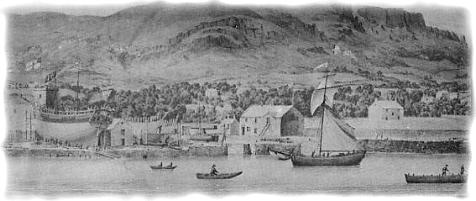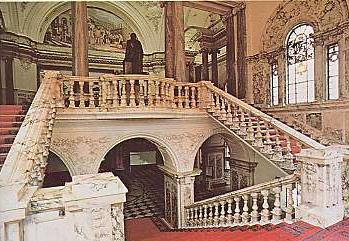|
| |
| Belfast
is the capital of Northern Ireland, it is situated in eastern Northern
Ireland astride the River Lagan at the head of Belfast Lough, in 1177
John de Courcy built a castle commanding the ford of the Lagan, the town
played a subordinate roll in early times to Carrickfergus The city derives its name from Béal Feirste, the Mouth of the Farset. which rises above Legoniel it is now contained within a tunnel which runs beneath High Street and joins the River Lagan a little to the east of the Albert Clock. Just to the north of Belfast is The Cave Hill, or Benmadigan “Madagán’s peak” t appears to be named from kings called Madudhán “little dog”, the caves are shown on 16th-century maps of the area. In the lead up to the 1798 Rebelion some of the leaders met at McArts fort on Cave Hill. The forces of Edward Bruce destroyed Belfast Castle in 1316 but it was subsequently rebuilt. For about three hundred years the O'Neill family controlled the Lagan valley area until 1574 when it was captured by the Earl of Essex. In 1603 as part of the plantation, Belfast came under the control of Arthur Chichester he was granted a charter of incorporation in 1613, after which the town became a market and trading center. Real growth began in 1685 with an influx of French Huguenots who brought with them knowledge of the linen industry, and a vibrant work ethic. The beginnings of the shipbuilding industry which was to make the town world famous, is credited to William Hugh Ritchie who opened a shipyard there in 1791, it was also in that year The United Irishmen were formed to fight the repression of the penal laws, this origination enjoyed wide support in the Catholic and Presbyterian communities who both suffered discrimination. In 1800 the Act of Union brought a period of un presented prosperity and the town became a major industrial centre. The population of Belfast grew from 30,000 in 1831 to 350,000 in 1901. It was made a city in 1888, and in 1892 had a Lord Mayor. During the 19th century, the harbour was enlargement, and the existing shipbuilding industry, began to develop on a large scale. Belfast was made the capital of the newly established Northern Ireland in 1920, when the country was partitioned in the Government of Ireland Act. The first parliament of Northern Ireland was convened in the City Hall in 1921 and was opened by King George V. A new parliament building was built at Stormont, the government was moved there in 1932 and opened by The Prince of Wales, and continued until it was suspended in 1972 by the English government. During the second world was Belfast was bombed heavily by the Germans targeting the shipyards, during the months of April and may 1941 over one thousand people were killed in these air raids. unlike industrial city's in England Belfast was almost totally devoid of anti aircraft protection, to the best of my knowledge one warship anchored in the Lough was the sum total of the defenses. Less than thirty years later between 1969 and 1994, the city was again attacked and extensively damaged by explosives and incendiaries devices planted by the provisional IRA In August 1994 a peace accord was declared, bringing to the city an uneasy peace. The so-called Good Friday Peace Agreement, signed in Belfast in April 1998, was a further milestone in the normalization of relations between various political groups, although not all factions accepted the agreement. In December 1999 power in the province was devolved to the Northern Ireland Assembly, which sits in Belfast, in Parliament Buildings in Stormont. Belfast is home to about 18 per cent of the population of Northern Ireland, the city is the location for 30 per cent of manufacturing companies and about 20 per cent of all retailing activity takes place in the city. Like any major city Belfast has its share of robberies and crime much of which is linked to paramilitary organizations spawned by the troubles vieing with each other to control the drug trade and various other rackets. Since the cessation of violence in 1994, Belfast has enjoyed its first opportunity for over 25 years to try to attract new economic activity. The port area has recently undergone massive redevelopment and is now equipped with modern cargo and passenger-handling facilities. These rank with the best in Europe and handle goods traveling between domestic ports such as Stranraer, Liverpool, and Swansea and container freight to and from Scandinavia, the Baltic, and Rotterdam. In 1996 a new fast ferry service began operating
from The city council intends to promote investment and tourism and to bring about economic regeneration. Situated on the banks of the Lagan in the heart of the central business district, the Belfast Waterfront Hall is the city’s new major international conference and performing arts centre; it was opened in early 1998. Nearby is the newly refurbished St George's Market, originally built in 1896, which reopened at the end of the 1990s. There is also a new Hilton hotel and redevelopment of the site of the former city gasworks. The latest project (Late 2005) announced for Northern Ireland is an Olympic stadium various propositions have been put foreword to site it in or around Belfast, but the government favour's the site of the old Maze prison outside Lisburn about ten miles east. The river itself has also been an area which has seen much improvement. Former industrial activity had affected water quality in the River Lagan seriously. The Laganside Corporation has undertaken the construction of the new Lagan Weir at Donegal Quay. Dredging of the former mudflat area and improvements to sewage treatment have helped to encourage a wide range of fish species back to the river not seen for a considerable time. Queen's University of Belfast was designed by Charles Lanyon, the most prolific of Belfast's architects. In 1995 the university celebrated its sesquicentennial. During its 150 years, Queen's has developed a reputation as one of Europe's leading centre's for innovation and technology transfer. It has recently opened the Northern Ireland Technology Centre, one of a number of initiatives by the university that link it to business, research, and design. In 1984 the University of Ulster was formed from the merger of Ulster Polytechnic and the New University of Ulster; Belfast is home to one of the campuses of this university. Each November the city holds the “Belfast Festival at Queen's”, a major festival that has attracted the Royal Swedish Ballet, the Chinese State Circus, the Montreal Symphony Orchestra, and the Royal Shakespeare Company. During July in Dixon Park, an international rose festival is held. The park is famous for its roses and grows up to 100,000 blooms throughout the summer months. Attractions in Belfast include the 20th-century St Anne's Cathedral, the much bombed and restored city Opera House, dating originally from 1895, and the Crown Liquor Saloon, one of the most famous of the city's public houses, which has been restored by the National Trust. There is also the city hall and Stormont Castle (Belfast headquarters of the Secretary of State for Northern Ireland), the Ulster Museum in the Botanic Gardens, the Arts Council Sculpture Park, and the Linen Hall Library, established in 1788, which has a Robert Burns collection. In Waring Street is the Ulster Bank (1860), with a beautiful Venetian palace interior. The origin of Belfast Street Names Read The Story of Belfast by Mary Lowry |
||
Lots
of historical info about Belfast
Eddies Book Extracts |
|



 which
de Courcy chose as his main power base in Ulster, he began the construction
of
which
de Courcy chose as his main power base in Ulster, he began the construction
of  Stranraer, Improvements in these transport links have been crucial in
attracting overseas companies to Northern Ireland. Around the port of
Belfast, development land has been set aside for new factories and warehouses
which will also be close to the city centre, to Belfast Harbour Airport,
and to Belfast International Airport at Aldergrove, 32 km (20 mi) west
of the city.
Stranraer, Improvements in these transport links have been crucial in
attracting overseas companies to Northern Ireland. Around the port of
Belfast, development land has been set aside for new factories and warehouses
which will also be close to the city centre, to Belfast Harbour Airport,
and to Belfast International Airport at Aldergrove, 32 km (20 mi) west
of the city.